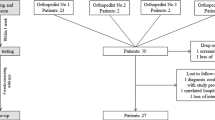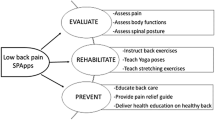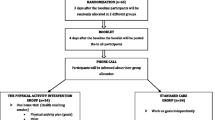Abstract
Background
Mobile health (mHealth) is emerging as the most convenient way to deliver rehabilitation services remotely, and collect outcomes in real time, thus contributing to disease management by transferring care from hospital to home. It facilitates accessibility to healthcare, enhances patients’ understanding of their condition, and their willingness to engage in self-management, giving way to high-quality care to the satisfaction of both patients and healthcare professionals.
Purpose
The purpose of this study was to examine the effect of using a smartphone app (called Snapcare) on pain and function in patients suffering from chronic low back pain.
Methods
Ninety-three patients with chronic low back pain were recruited and randomly allocated to either the Conventional group (n = 48) receiving a written prescription from the Physician, containing a list of prescribed medicines and dosages, and stating the recommended level of physical activity (including home exercises) or the App group (n = 45) receiving Snapcare, in addition to the written prescription. Pain and disability were assessed at baseline and after 12 weeks of treatment.
Results
Both the groups showed significant improvement in pain and disability (p < 0.05). The App group showed a significantly greater decline in disability (p < 0.001).
Conclusion
Health applications are promising tools for improving outcomes in patients suffering from various chronic conditions. Snapcare facilitated increase in physical activity and brought about clinically meaningful improvements in pain and disability in patients with chronic low back pain.
Graphical abstract
These slides can be retrieved under Electronic Supplementary Material.




Similar content being viewed by others
References
Loney PL, Stratford PW (1999) The prevalence of low back pain in adults: a methodological review of the literature. Phys Ther 79(4):384–396
Walker BF, Muller R, Grant WD (2004) Low back pain in Australian adults. Prevalence and associated disability. J Manip Physiol Ther 27(4):238–244
Oleske DM, Lavender SA, Andersson GB, Morrissey MJ, Zold-Kilbourn P, Allen C, Taylor E (2006) Risk factors for recurrent episodes of work-related low back disorders in an industrial population. Spine 31(7):789–798
Frymoyer JW (1992) Predicting disability from low back pain. Clin Orthop Relat Res 279:101–109
Andersson GBJ (1997) The epidemiology of spinal disorders. In: Frymoyer JW (ed) The adult spine: principles and practice. Lippincott-Raven, Philadelphia, pp 93–141
Taimela S, Kujala UM, Salminen JJ, Viljanen T (1997) The prevalence of low back pain among children and adolescents: a nationwide, cohort-based questionnaire survey in Finland. Spine 22(10):1132–1136
Charlton JE (2005) Core Curriculum for Professional Education in Pain, 3rd edn. International Association of the Study of Pain (IASP) Press, Seattle
Schoppink LE, van Tulder MW, Koes BW, Beurskens SA, de Bie RA (1996) Reliability and validity of the Dutch adaptation of the Quebec back pain disability scale. Phys Ther 76(3):268–275
Vos T, Flaxman AD, Naghavi M, Lozano R, Michaud C, Abraham J et al (2013) Years lived with disability (YLDs) for 1160 sequelae of 289 diseases and injuries 1990–2010: a systematic analysis for the Global Burden of Disease Study 2010. Lancet 380(9859):2163–2196
Beurskens AJ, Henrica C, Köke AJ, van der Heijden GJ, Knipschild PG (1995) Measuring the functional status of patients with low back pain: assessment of the quality of four disease-specific questionnaires. Spine 20(9):1017–1028
Beurskens AJ, De Vet HC, Köke AJ (1996) Responsiveness of functional status in low back pain: a comparison of different instruments. Pain 65(1):71–76
Beurskens AJ, Henrica C, Kökeb AJ, Lindeman E, van der Heijden GJ, Regtope W et al (1999) A patient-specific approach for measuring functional status in low back pain. J Manip Physiol Ther 22(3):144–148
Ostelo RW, de Vet HC (2005) Clinically important outcomes in low back pain. Best Pract Res Clin Rheumatol 19(4):593–607
Smith JA, Osborn M (2007) Pain as an assault on the self: an interpretative phenomenological analysis of the psychological impact of chronic benign low back pain. Psychol Health 22(5):517–534
Painter JR, Seres JL, Newman RI (1980) Assessing benefits of the pain center: why some patients regress. Pain 8(1):101–113
Sanders SH (1983) Automated versus self-monitoring of ‘up-time’ in chronic low-back pain patients: a comparative study. Pain 15(1–4):399–405
Follick MJ, Ahern DK, Laser-Wolston N (1984) Evaluation of a daily activity diary for chronic pain patients. Pain 19(4):373–382
Bradley LA, Prokop CK, Margolis R, Gentry WD (1978) Multivariate analyses of the MMPI profiles of low back pain patients. J Behav Med 1(3):253–272
Armentrout DP, Moore JE, Parker JC, Hewett JE, Feltz C (1982) Pain-patient MMPI subgroups: the psychological dimensions of pain. J Behav Med 5(2):201–211
Fordyce WE (1976) Behavioral Concepts in Chronic Pain and Illness. CV Mosby, St. Louis
McNeill TH, Warwick DA, Andersson GU, Schultz AL (1979) Trunk strengths in attempted flexion, extension, and lateral bending in healthy subjects and patients with low-back disorders. Spine 5(6):529–538
Addison R, Schultz A (1980) Trunk strength in patients seeking hospitalization for chronic low-back disorders. Spine 5:539–544
Mayer TG, Tencer AF, Kristoferson S, Mooney V (1984) Use of noninvasive techniques for quantification of spinal range-of-motion in normal subjects and chronic low-back dysfunction patients. Spine 9(6):588–595
Kishino ND, Mayer TG, Gatchel RJ, Parrish MM, Anderson C, Gustin L et al (1985) Quantification of lumbar function: Part 4: isometric and isokinetic lifting simulation in normal subjects and low-back dysfunction patients. Spine 10(10):921–927
Mayer TG, Smith SS, Keeley J, Mooney V (1985) Quantification of lumbar function: part 2: sagittal plane trunk strength in chronic low-back pain patients. Spine. 10(8):765–772
Keeley J, Mayer TG, Cox R, Gatchel RJ, Smith J, Mooney V (1986) Quantification of lumbar function: part 5: reliability of range-of-motion measures in the sagittal plane and an in vivo torso rotation measurement technique. Spine. 11(1):31–35
Mayer TG, Barnes D, Nichols G, Kishino ND, Coval K, Piel B et al (1988) Progressive Isoinertial Lifting Evaluation. II. A comparison with isokinetic lifting in a disabled chronic low-back pain industrial population. Spine 3(9):998–1002
Curtis L, Mayer TG, Gatchel RJ (1994) Physical progress and residual impairment quantification after functional restoration. Part III: Isokinetic and isoinertial lifting capacity. Spine 19:401–405
Hägg O, Fritzell P, Nordwall A (2003) The clinical importance of changes in outcome scores after treatment for chronic low back pain. Eur Spine J 12(1):12–20
Hartigan C, Rainville JA, Sobel JB, Hipona MA (2000) Long-term exercise adherence after intensive rehabilitation for chronic low back pain. Med Sci Sports Exerc 32(3):551–557
Mayer TG, Gatchel RJ, Mayer H, Kishino ND, Keeley J, Mooney V (1987) A prospective two-year study of functional restoration in industrial low back injury: an objective assessment procedure. JAMA 258(13):1763–1767
Spitzer WO (1987) Scientific approach to the assessment and management of activity-related spinal disorders: a monogram for clinicians. Report of the Quebec task force on spinal disorders. Spine 12:S1–S60
Waddell G (1987) Volvo Award in Clinical Sciences: A new clinical model for the treatment of low-back pain. Spine 12(7):632–644
Manniche C, Bentzen L, Hesselso̸e G, Christensen I, Lundberg E (1988) Clinical trial of intensive muscle training for chronic low back pain. Lancet 332(8626–8627):1473–1476
Koes BW, Bouter LM, Beckerman H, Van Der Heijden GJ, Knipschild PG (1991) Physiotherapy exercises and back pain: a blinded review. BMJ 302(6792):1572–1576
Nordin M, Campello M (1999) Physical therapy. Neurol Clin 17(1):75–89
van der Velde G, Mierau D (2000) The effect of exercise on percentile rank aerobic capacity, pain, and self-rated disability in patients with chronic low-back pain: a retrospective chart review. Arch Phys Med Rehabil 81(11):1457–1463
Pinto RZ, Ferreira PH, Kongsted A, Ferreira ML, Maher CG, Kent P (2014) Self-reported moderate-to-vigorous leisure time physical activity predicts less pain and disability over 12 months in chronic and persistent low back pain. Eur J Pain 18(8):1190–1198
Vuori IM (2001) Dose-response of physical activity and low back pain, osteoarthritis, and osteoporosis. Med Sci Sports Exerc 33(6 Suppl):S551–S586
Blanchard CM, Courneya KS, Rodgers WM, Fraser SN, Murray TC, Daub B, Black B (2003) Is the theory of planned behavior a useful framework for understanding exercise adherence during phase II cardiac rehabilitation? J Cardiopulm Rehabil Prev 23(1):29–39
Sluijs EM, Kok GJ, Van der Zee J (1993) Correlates of exercise compliance in physical therapy. Phys Ther 73(11):771–782
Reilly K, Lovejoy B, Williams R, Roth H (1989) Differences between a supervised and independent strength and conditioning program with chronic low back syndromes. J Occup Environ Med 31(6):547–550
Sluijs EM, Knibbe JJ (1991) Patient compliance with exercise: different theoretical approaches to short-term and long-term compliance. Patient Educ Couns 17(3):191–204
Nelson BW, Miller M, Hogan M, Wegner JA, Kelly C (1995) The clinical effects of intensive, specific exercise on chronic low back pain: a controlled study of 895 consecutive patients with 1-year follow up. Orthopedics 18(10):971–981
Linton SJ, Hellsing AL, Bergström G (1996) Exercise for workers with musculoskeletal pain: does enhancing compliance decrease pain? J Occup Rehabil 6(3):177–190
Middleton A (2004) Chronic low back pain: patient compliance with physiotherapy advice and exercise, perceived barriers and motivation. Phys Ther Rev 9(3):153–160
Rimmer JH, Wang E, Smith D (2008) Barriers associated with exercise and community access for individuals with stroke. J Rehabil Res Dev 45(2):315
Bassett SF (2003) The assessment of patient adherence to physiotherapy rehabilitation. New Zealand Journal of Physiotherapy. 31(2):60–66
Cranen K, Drossaert CH, Brinkman ES, Braakman-Jansen AL, IJzerman MJ, Vollenbroek-Hutten MM (2012) An exploration of chronic pain patients’ perceptions of home telerehabilitation services. Health Expect 5(4):339–350
Kay M, Santos J, Takane M (2011) mHealth: New horizons for health through mobile technologies. World Health Organ 64(7):66–71
Whittaker R (2012) Issues in mHealth: findings from key informant interviews. J Med Internet Res 14(5):e129
Fogg BJ, Adler R (2009) Texting 4 Health: a simple, powerful way to change lives. Captology Media, Palo Alto
Fiordelli M, Diviani N, Schulz PJ (2013) Mapping mHealth research: a decade of evolution. J Med Internet Res 15(5):e95
Mosa AS, Yoo I, Sheets L (2012) A systematic review of healthcare applications for smartphones. BMC Med Inform Decis Mak 12(1):67
De La Torre-Díez I, López-Coronado M, Vaca C, Aguado JS, de Castro C (2015) Cost-utility and cost-effectiveness studies of telemedicine, electronic, and mobile health systems in the literature: a systematic review. Telemed e-Health 21(2):81–85
Iribarren SJ, Cato K, Falzon L, Stone PW (2017) What is the economic evidence for mHealth? A systematic review of economic evaluations of mHealth solutions. PLoS ONE 12(2):e0170581
Evans WD, Abroms LC, Poropatich R, Nielsen PE, Wallace JL (2012) Mobile health evaluation methods: the Text4baby case study. J Health Commun 17(sup1):22–29
Schulz KF, Altman DG, Moher D (2010) CONSORT 2010 Statement: updated guidelines for reporting parallel group randomised trials. J Pharmacol Pharmacother 1(2):100–107
Chan AW, Tetzlaff JM, Altman DG, Laupacis A, Gøtzsche PC, Krleža-Jerić K et al (2013) SPIRIT 2013 statement: defining standard protocol items for clinical trials. Ann Intern Med 158(3):200–207
Multani NK, Singh B, Garg S (2006) Effectiveness of telemedicine services integrated into physiotherapeutic health care system. J Exerc Sci Physiother 2:87–91
Global Recommendations on Physical Activity for Health. Geneva: World Health Organization; 2010
Schaller A, Froboese I (2014) Movement coaching: study protocol of a randomized controlled trial evaluating effects on physical activity and participation in low back pain patients. BMC Musculoskelet Disord 15(1):391
Fritz JM, Irrgang JJ (2001) A comparison of a modified Oswestry low back pain disability questionnaire and the Quebec back pain disability scale. Phys Ther 81(2):776–788
Follick MJ, Smith TW, Ahern DK (1985) The Sickness Impact Profile: a global measure of disability in chronic low back pain. Pain 21(1):67–76
Machado GC, Pinheiro MB, Lee H, Ahmed OH, Hendrick P, Williams C, Kamper SJ (2017) Smartphone apps for the self-management of low back pain: a systematic review. Best Pract Res Clin Rheumatol 30(6):1098–1109
Hamine S, Gerth-Guyette E, Faulx D, Green BB, Ginsburg AS (2015) Impact of mHealth chronic disease management on treatment adherence and patient outcomes: a systematic review. J Med Internet Res 17(2):e52
Beratarrechea A, Lee AG, Willner JM, Jahangir E, Ciapponi A, Rubinstein A (2014) The impact of mobile health interventions on chronic disease outcomes in developing countries: a systematic review. Telemed e-Health 20(1):75–82
Williams V, Price J, Hardinge M, Tarassenko L, Farmer A (2014) Using a mobile health application to support self-management in COPD: a qualitative study. Br J Gen Pract 64(624):e392–e400
Kirwan M, Vandelanotte C, Fenning A, Duncan MJ (2013) Diabetes self-management smartphone application for adults with type 1 diabetes: randomized controlled trial. J Med Internet Res 15(11):e235
Wu Y, Yao X, Vespasiani G, Nicolucci A, Dong Y, Kwong J, Li L, Sun X, Tian H, Li S (2017) Mobile App-Based Interventions to Support Diabetes Self-Management: A Systematic Review of Randomized Controlled Trials to Identify Functions Associated with Glycemic Efficacy. JMIR Mhealth Uhealth 5(3):e35
Brouwer S (2004) Disability in Chronic Low Back Pain: psychometric properties of ADL-and work-related instruments. Groningen: s.n. 107p
Davidson M, Keating JL (2002) A comparison of five low back disability questionnaires: reliability and responsiveness. Phys Ther 82(1):8–24
Tonosu J, Takeshita K, Hara N, Matsudaira K, Kato S, Masuda K, Chikuda H (2012) The normative score and the cut-off value of the Oswestry Disability Index (ODI). Eur Spine J 21(8):1596–1602
Hicks GE, Manal TJ (2009) Psychometric properties of commonly used low back disability questionnaires: are they useful for older adults with low back pain? Pain Med 10(1):85–94
Manini TM, Pahor M (2009) Physical activity and maintaining physical function in older adults. Br J Sports Med 43(1):28–31
Nelson ME, Rejeski WJ, Blair SN, Duncan PW, Judge JO, King AC et al (2007) Physical activity and public health in older adults: recommendation from the American College of Sports Medicine and the American Heart Association. Circulation 116(9):1094
Conroy MB, Yang K, Elci OU, Gabriel KP, Styn MA, Wang J et al (2011) Physical activity self-monitoring and weight loss: 6-month results of the SMART trial. Med Sci Sports Exerc 43(8):1568
Mansi S, Milosavljevic S, Baxter GD, Tumilty S, Hendrick P (2014) A systematic review of studies using pedometers as an intervention for musculoskeletal diseases. BMC Musculoskelet Disord 15(1):231
McDonough SM, Tully MA, Boyd A, O’Connor SR, Kerr DP, O’Neill SM et al (2013) Pedometer-driven walking for chronic low back pain a feasibility randomized controlled trial. Clin J Pain 29(11):972
Durstine JL, Painter P, Franklin BA (2001) Erratum: physical activity for the chronically ill and disabled (Sports Medicine (2000) 30: 3 (207–2191)). Sports Med 31(8):627
Ettinger WH, Burns R, Messier SP, Applegate W, Rejeski WJ, Morgan T et al (1997) A randomized trial comparing aerobic exercise and resistance exercise with a health education program in older adults with knee osteoarthritis: the Fitness Arthritis and Seniors Trial (FAST). JAMA 277(1):25–31
Keysor JJ (2003) Does late-life physical activity or exercise prevent or minimize disablement?: a critical review of the scientific evidence. Am J Prev Med 25(3):129–136
Gretebeck RJ, Ferraro KF, Black DR, Holland K, Gretebeck KA (2012) Longitudinal change in physical activity and disability in adults. Am J Health Behav 36(3):385–394
Pahor M, Guralnik JM, Ambrosius WT, Blair S, Bonds DE, Church TS et al (2014) Effect of structured physical activity on prevention of major mobility disability in older adults: the LIFE study randomized clinical trial. JAMA 311(23):2387–2396
Anderson K, Burford O, Emmerton L (2016) Mobile health apps to facilitate self-care: a qualitative study of user experiences. PLoS ONE 11(5):e0156164
Zichermann G, Cunningham C (2011) Gamification by design: Implementing game mechanics in web and mobile apps. O'Reilly Media Inc, Sebastopol, CA
Acknowledgements
The authors would like to thank Ranjeet Randhawa (CEO, Snapcare Technologies) for providing the app free of cost for patient use. The authors would also like to acknowledge the work of our language editor, Ms. Shivani Verma and finally, the participants for their time and cooperation.
Funding
The study was supported by Snapcare Technologies Pvt. Ltd.
Author information
Authors and Affiliations
Corresponding author
Ethics declarations
Conflict of interest
The corresponding author is a research consultant for Snapcare Technologies Pvt. Ltd. The authors derived no financial benefit from sales or from publication of this research. The data from the app were obtained from two independent observers not related to Snapcare Technologies Pvt. Ltd.
Ethical standards
The study was approved by the Institutional Ethical Committee, Indian Spinal Injuries Centre and an informed consent obtained from all participants. (Date: 28 July 2016; IEC reference No: ISIC/RP/2015/047).
Electronic supplementary material
Below is the link to the electronic supplementary material.
Appendices
Appendix 1

Appendix 2

Appendix 3

Appendix 4

Rights and permissions
About this article
Cite this article
Chhabra, H.S., Sharma, S. & Verma, S. Smartphone app in self-management of chronic low back pain: a randomized controlled trial. Eur Spine J 27, 2862–2874 (2018). https://doi.org/10.1007/s00586-018-5788-5
Received:
Revised:
Accepted:
Published:
Issue Date:
DOI: https://doi.org/10.1007/s00586-018-5788-5




